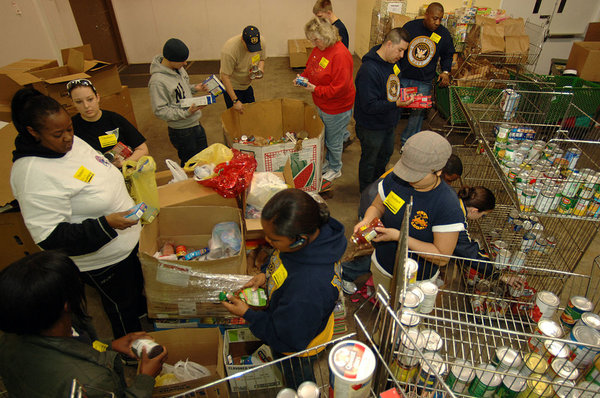Photo Caption: US Navy Sailors sort through food items checking expiration dates while volunteering at the Food Bank of Southeastern Virginia
One-Third Of The World’s Food Is Wasted From Plough To Plate.
The sheer volume of food waste is disturbing, especially in a world where food insecurity and starvation is a reality for many. Not to mention the environmental impact of wasted food ending up in landfills where it decomposes and produces methane gas leading to increased global warming.
Until a few years ago the colossal scale of food waste was largely unaddressed but has now come into the spotlight globally.
Why does food get wasted?
For many reasons. Between the time food leaves the farms and reaches our homes, food goes through a number of processes that make up a long supply chain and food is lost at every step of the way.
One area of food waste we’d like to focus on today is food expiration dates. Use-by and best before dates, do you know the difference between them?

What are use-by and best before dates?
Food Authority NSW describes them as…**
‘use-by’: foods must be eaten or thrown away by the date
- After this date, foods may be unsafe to eat even if they look fine because the nutrients in the food may become unstable or a build-up of bacteria may occur.
- It is illegal to sell foods after a ‘use-by’ date.
- Common ‘use-by’ foods include milk, sliced ham and shaved meats.
‘best before’: foods are still safe to eat after the date as long as they are not damaged, deteriorated or perished
- The ‘best before’ date simply indicates that the product may lose some of its quality after this date passes.
- Foods can be legally sold after a ‘best before’ date as long as they are not damaged, deteriorated or perished.
- You can expect these foods to retain their colour, taste, texture and flavour as long as they are stored correctly.
- Common ‘best before’ foods include canned foods, cereals, biscuits, sauces, chocolate, sugar, flour and frozen foods.
What does it have to do with food waste?
Many of us treat all printed expiration dates as though they’re ‘use-by’ dates and this leads to good food ending up in the bin.
Best before dates create confusion and cause many households to discard food items wrongly due to worry it is no longer fit for consumption. In many of these instances, the food is probably perfectly ok to eat, especially if the food items have been stored correctly.
Read more: How to store onions, garlic and shallots to make them last longer
You don’t need to throw out your common sense, because ultimately if it looks bad, if it smells bad, chances are it is. But, being more mindful about what use-by and best before dates actually mean could stop a lot of edible food ending up in the trash.
Back in 2014, the European Union even proposed to scrap compulsory ‘best before’ labels altogether on coffee, rice, dry pasta, hard cheeses, jams and pickles to help reduce the estimated 100 million tons of food wasted across Europe each year.
“We think citizens can make sure themselves if, for instance, rice is still usable.”
– Said Dutch Minister Sharon Dijksma
We too think people are capable of making such judgements themselves.
Food waste has a whole lot to do with attitude
You could take the approach that because your bananas have some brown spots, or the onion has started sprouting in the cupboard, you’ll throw them away. But why would you when you could mash up those bananas and make some banana pumpkin bread, or turn that onion into the perfect topping for these heavenly sweet potatoes?
Read more: 10 perfectly good food scraps you’re probably throwing away
Store your food correctly, and in the right conditions to keep it safe from spoiling early and use your common sense when it comes to food expiration labels.
Not only will you reduce your households waste significantly, but you’ll end up with savings in your pocket too, because ultimately when we throw out good food we’re throwing money away as well.
*http://news.nationalgeographic.com/news/2014/10/14…
**http://www.foodauthority.nsw.gov.au/fp/understandi…
Photo Source: Shutterstock
1 Million Women is more than our name, it’s our goal! We’re building a movement of strong, inspirational women acting on climate change by leading low-carbon lives. To make sure that our message has an impact, we need more women adding their voice. We need to be louder. Joining us online means your voice and actions can be counted. We need you.
Top Photo Source: Wikimedia Commons for Creative Commons images
Source: 1 Million Women
